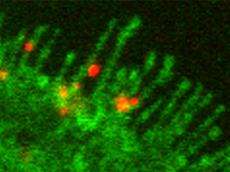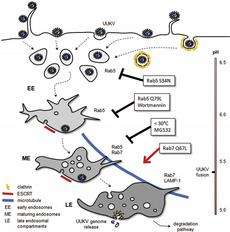A cell turns into a virus factory

Bunyaviruses are poorly researched, despite their diversity and importance in relation to animal and human diseases. ETH Zurich researchers led by virologist Ari Helenius have now discovered the tricks used by the Uukuniemi virus, a representative of this distinguished virus community, to sneak into cells.
Few people are likely to be familiar with bunyaviruses but many will know the illnesses they cause: Hanta or Rift Valley fever make headlines from time to time. In Germany, for example, hantavirus infections were among the five most common reportable virus diseases in 2007, with just under 1,700 cases.
In fact, several hundred bunyavirus species are known to science but they are poorly researched, despite or perhaps because of their hazardous nature. The majority of these viruses are transmitted by insects, except for hantaviruses, which spread through the excreta of mice and rats. Until now, it was not known how these viruses gain entry into a cell in order to make use of the cell’s copying machinery.
Using a bunyavirus that is harmless to humans, the Uukuniemi virus, researchers in the group led by Ari Helenius, Professor of Biochemistry at ETH Zurich, have now studied how these viruses penetrate cells. The model they have obtained is valid for a large number of bunyaviruses.
Dendritic cells as couriers
Uukuniemi viruses also enter their victim through an insect bite. These viruses specifically seek out so-called dendritic cells under the skin. These have long antennae, the filopodia, on their surface, which act as sensors and “search” for foreign bodies. Having found them - the viruses, in this case - they carry them to the lymph nodes where they present their “catch”, thus triggering the immune response. Bunyaviruses exploit this situation. The unintentional help from the dendritic cells is exactly what allows the viruses to reach every organ via the lymphatic vessels.
To penetrate dendritic cells, the viruses bond to their filopodia and allow themselves to be transported to the cell surface. Once there, the virus ensures that it is engulfed by the cell membrane and pinches off a small vesicle (pocket) into the cell’s interior - a Trojan Horse containing the virus that is fatal to the cell.

Acidic environment suits the virus
The cell carries the vesicle to a lysosome, which virtually serves as its digestive tract with numerous enzymes. On its way there, the virus-laden vesicle matures by absorbing protons, which reduces the acidity in the vesicle. As soon as the environment is sufficiently acidic, with a pH of 5.5, the crucial phase occurs: the virus envelope fuses with the vesicle’s envelope membrane and the RNA strands containing the blueprint for the virus enter the cell. This happens even before the lysosome “swallows” the vesicle and digests its contents. The virus has achieved its aim: from now on the cell will only manufacture viruses.
Ari Helenius thinks it is particularly remarkable that the Uukuniemi virus, and thus other bunyaviruses as well, wait until a rather late point in time before unloading their cargo. Around 20 minutes elapse from the moment the vesicle is pinched off from the cell membrane until it releases its contents into the cell. With other viruses, the vesicle is already emptied after 5 minutes. At first sight, bunyaviruses are not very successful either, since only a small proportion of the particles dock onto the cell surface. However, once they have infiltrated the cell they are merciless: each cell produces up to thousands of virus particles, which infect new cells. “The cell becomes a virus factory,” says Helenius.
Analysing communication
Helenius and his group have now studied the penetration mechanisms of eight different virus groups. However, the work on the Uukuniemi virus is the first fundamental study of how bunyaviruses penetrate cells, although the results are not limited to this virus. “The Rift Valley fever virus, for example, behaves very similarly,” says Pierre-Yves Lozach, first author of the study published recently in “Cell Host & Microbe”. For this reason, the results are readily transferable to other members of this family of viruses.
For the virus to succeed in its plan, it must communicate with the cell, mostly via proteins. These in turn are produced by genes. An analysis showed the ETH Zurich biologists that about 1,000 human genes are needed when the Uukuniemi virus penetrates a cell. The researchers are now looking for a needle in the genetic haystack, i.e. proteins that the virus urgently needs if it is to be successful, but which are of scarcely any use to the cell. Once these proteins are identified, a search can be carried out for medicinal active ingredients that can block them, thus interrupting the fatal chain of infection.
More information: Lozach P-Y, Mancini R, Bitto D, Meier R, Oestereich L, Överby AK, Pettersson RF, Helenius A. Entry of Bunyaviruses into Mammalian Cells. Cell Host & Microbe, Volume 7, Issue 6, 488-499, 17 June 2010. DOI: 10.1016/j.chom.2010.05.007
Provided by ETH Zurich
















